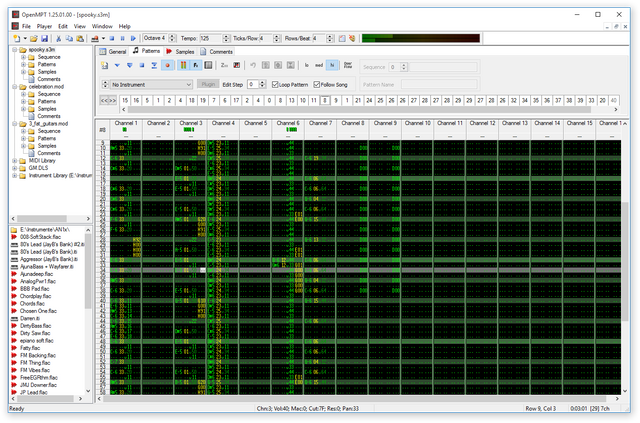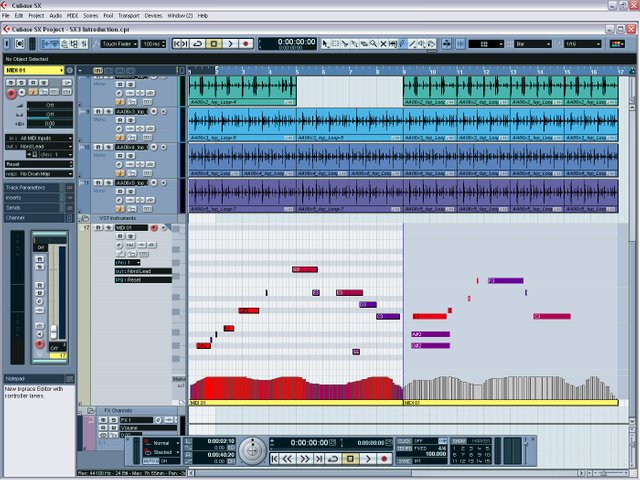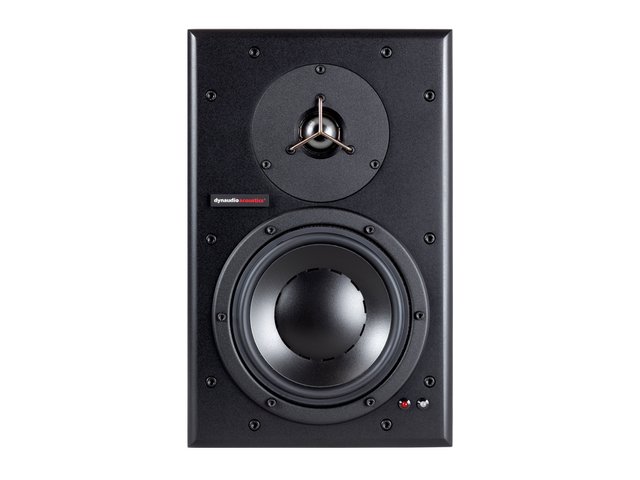Music Production Software: My path from past to present
I will go through most of the DAWS (digital audio workstations) and some of the plugins that I’ve used through the years. It’s quite a long post, but there might be some useful information for you, so bear with me. I'd also like to mention that I'm not the original author of the music presented in the Youtube-videos. They are simply just examples of how the programs work.
The very beginning (mid 1990's)
Trackers. For me it all started with trackers. I remember I was sitting in front of my cousin's Amiga 500 computer and he showed me this intriguing program called ProTracker. I think this happened somewhere during the mid-nineties. I was maybe around 10 years old. The great soundtracks of Amiga 500 games already had put their spell on me, but this program opened a totally new dimension. The fact that you could make such good sounding music with just your home computer totally blew my mind.
Tracker "modules" (as the song files are called) consist of note sequences, which are divided in to separate parts that are called "patterns". These sequences are presented as lists which the program reads vertically. ProTracker could play only 4 different sounds simultaneously, meaning it had 4 "channels". The sounds were pre-recorded samples and the program didn't have any synthesizing capabilities or effects such as reverb, delay, etc. Melodies were mostly made with just changing the pitch of a single sample.
Many trackerists recorded their own sounds from synthesizers or other convenient sources. People were also trading samples on floppy disks and ripping them from other modules. There was a whole scene of composers and they were connected mostly via Bulletin Board Systems.
A bit later I got introduced to trackers on PC. These programs were called Scream Tracker (made in Finland by the way) and Fast Tracker 2. They were based on the exact same idea that ProTracker was, but they had more channels, more samples, panning for each channel etc. The sound quality was similar to Amiga 500 with the early Sound Blaster 16 sound card on PC (better than the ear ripping PC speaker anyway).
My friend @drakmin was often showing me his early compositions and sometimes I was watching him making them and I might have even given him some super great ideas. The way of composing with trackers has always been somehow fast and intuitive. The interface was quite easy for us to get in to even as kids. You just chose a sampled sound, used your computer's keyboard to input the notes (similarly to ableton live) and "navigated" with the arrow keys. There were also all kinds of commands that you could input to manipulate the pitch of the sounds, the volume, the song tempo etc.
The first steps (late 1990's)
In 1997 I got my first proper computer. I don't remember the specs but it was good enough for me to start experimenting with some music making tools. Soon I also got connected to internet which opened a door to a community of other trackerists. That time I mainly used IRC for communication. I found some likeminded music makers from a channel called #trax. I also got introduced to many ”modlabels”. They were basically groups of people who released free mods on their webpages. I was trying out many different styles and non-styles of music, discovering some basic methods and taking my first steps with FT2. At some point I made a very crude demo cd with some weird tracks on it and sent it to this radio program specialized with experimental electronic music. My track got played in the demo section of the program and I remember I was super excited.
Through some IRC-channels I got in contact with some actual small independent record labels and got some tracks released. All this stuff was still made with FT2, but I had also discovered a program called Audiomulch which I sometimes used as a "mastering tool". Back then I didn't know much anything about proper mastering, I just thought it was cool because I could boost bass frequencies with it and add some reverb.
I also made some ambient experiments using Audiomulch and the built-in real time effects that my Sound Blaster Live!-soundcard had. The early version of Audiomulch had a very simple sequencer, sampler, effects and some sort of automation timeline. I didn’t keep up with it for too long, so I don’t know how advanced it is nowadays. During this period I also learned that you could get these separate audio effect plugin files which are compatible with many different music making programs. These plugins are called VST effects and instruments (Audio Units in Macintosh environment).
Slowly upgrading (early 2000’s)
Mad Tracker and OpenMPT brought the cool effects to the tracker environment. I’m not saying they necessarily were the first ones to do that, but they were the first ones for me. MT only had it’s native reverb, delay, chorus etc. but in OpenMPT you could use the more universal VST plugins. Though, you could only load something like 10 different effects to your module and assign one of them to each channel. Still this was a big improvement for me. Another upgrade was that you could load stereo samples in to it, but the program didn’t support any VST instruments yet. Slowly I started to learn how to use these effects ”properly”. I've seen that this kind of restricted way of working challenges you to squeeze the most out of something simple and small, instead of getting lost with too many options.
![]()

My interest towards music production had been growing stronger for some time already and I wanted to learn to use some proper studio software. I used Buzz Tracker for some time and liked the fact that it supported VST instruments but for some reason I didn’t stick to it. It was quite unstable too. I also tried some early version of Logic, but couldn’t get a single sound out of it, so I gave up. Youtube and it’s countless tutorial videos were not yet available and I was too lazy to read any manuals. Luckily I met some new friends who taught me Cubase Sx 3.

Somewhere around 2003, purely by chance I landed on to the planet Cubase (and I’m still there). The interface and the way of working in it is very different compared to the familiar trackers I had been using. This was one of the big changes that took a while for me to adapt in to, but it wasn’t a problem. I liked the fact that you can actually see the whole arrangement. It is much more visual than just a list of pattern numbers. The projects also were not divided in to fixed patterns. Instead can you draw boxes in the arrangement window and input your sequences to them, then organize the boxes the way you like. Automating the effects and synthesizers happens by drawing some cool curves which are controlling the parameters.
I already knew something about sound synthesis and a tiny bit of mixing but after entering to the world of Cubase, I started to dig deeper in to the ways of ”professional music production”. In the beginning there was a lot to learn, plenty of trials and errors too. Equalizing was mainly just boosting some bass frequencies and maybe some highs, never really cutting. Compression was often way too dramatic. The mixes were muddy and weird. Back then I was also lacking the two most important things: acoustically treated room and good speakers. My first monitors were some very small Edirol speakers that didn’t have almost any low end. But I knew that if I just kept on trying, reference-listening and studying, I could make progress. I spent few years getting familiar with various well known virtual effects and synths. To name a few, I was mainly practicing with the first Rob Papen’s Albino, NI Pro-53 and reFX Vanguard.
Getting a bit more serious about it (mid/late 2000’s and early 2010’s)
The music making had become my "main thing" already and I even had applied to a school to study it. Looking back, there wasn’t much else that interested me more than the world of sound production. I didn’t get in the first time I tried but in 2006 that door opened for me. In the school we were taught basics of many things related to studio engineering and the industry in general.
We had few different studio rooms there, each equipped with Genelec monitors (bigger and smaller models), Macs with Pro Tools, Logic, Cubase etc. There was also a big recording room where we could study some recording techniques with different microphones (I never really got to apply those in my own work, so most of the tricks are unfortunately forgotten). We also had some hardware synths there (Nord, Jp-8080 and some others) to practice the use of MIDI and sound synthesis.
Finally I got myself a proper pair of studio monitors (which I’m still using today): the older model of Dynaudio BM6As. And why did I get these particular speakers ? Well, I didn’t get to test listen them anywhere, so it was sort of a leap of faith. My good friend and room mate also got a pair of those for him, and since I had read some good reviews of them from some producers I respect, I thought to myself: why not ? I'm still like the sound of them, also just for recreational music listening.

I still didn’t have any acoustic treatment in my bedroom studio, so I just had to get used to the characteristics of the room I was working in. I also used analyzers such as PAZ from Waves and went to check the mix downs in our school’s studios.
ProTools was the main software that was taught in the school. It seemed like a good program for recording, but the MIDI features in it couldn’t compete with Cubase in my opinion. Also the editing felt some how difficult with it, but that’s just because I was so used to Cubase. I used the old SX3 and upgraded to Cubase 5 in 2009. I never felt the need to switch away from my main DAW of choice.
Today ?
After the studies I spent the years practicing my skills with countless hours of producing and trying to find the most suitable tools for my ways of working. The whole list of plugins that I’ve gone through would probably be too long to have here, but instead I can give you a short list of my go-to-plugins of today:
Lately I upgraded my Cubase to 8.5 version. I think it’s native plugins are very good quality and useful, so I use them a lot (with the exception of Sonalksis EQ which I use quite often too).

Native Instruments Komplete 11 is a super nice package of synths, tools, sounds and other cool stuff. I haven’t even tried out everything in it yet, as I try to learn the tools one by one properly. Massive and FM8 are good synths in it. Reaktor is definitely a nice dimension to dive in to.
In addition to Komplete’s synths, I often find myself using Xfer’s Serum for almost anything. It has a really nice sound to it, I like the LFOs and the ways you can connect things in it. I feel like there is still a lot of stuff that I can learn with it. Another, a bit more simple all around synth is LennarDigital’s Sylenth.
For going crazy with the sound design, I still like to use the old Glitch by Illformed with some newer plugins.
Compared to the time when I started this journey, things have changed a lot for sure. There’s an overload of tools and information. Now we just need to figure out where to find that information and decide which tools are the most suitable for us. There’s this mentality, that you should first learn to use just a couple of tools properly. I think it’s a very useful idea. Surely when you are advanced enough, new plugins can be inspirational at best. But there’s always a danger of drowning in to a deep sea of options and choices. Anyway, it’s definitely not about the amount of different fancy toys you have, it’s about how you apply them.
Thanks for reading! Any comments, suggestions and questions are more than welcome. Next post will probably be a short one. Let’s see…
Links:
ProTracker: https://sourceforge.net/projects/protracker/
Scream Tracker: http://www.pouet.net/prod.php?which=13351
Fasttracker 2: http://www.pouet.net/prod.php?which=13350
MadTracker: http://www.madtracker.org/main.php
OpenMPT: https://openmpt.org/
Audiomulch: http://www.audiomulch.com/
Buzz: http://jeskola.net/buzz/
Cubase: http://www.steinberg.net/en/home.html
Logic: http://www.apple.com/logic-pro/
ProTools: http://www.avid.com/pro-tools
Native Instruments: https://www.native-instruments.com/en/
Serum: https://www.xferrecords.com/
Sylenth1: https://www.lennardigital.com/sylenth1/
Nice, I haven't used Cubase in a while. Thanks for this post!!!
And who knows Harrison Mixbus?
When Logic becomes 'Mac only' I switch to Reason and Podium. Anybody knows? Podium by Zynewave.com Not most equiped DAW in the world but... the workflow! The workflow is awesome.
Sound Forge, Fruity Loops, Reason, and Abelton here.
I still use Sound Forge almost every day for other things.
Haven't touched the others in probably 8 years.
Ableton and Komplete usually have everything I need :D
Same here!
Yeah all those are familiar to me. I use Ableton live for live sets mostly, I've done some pre-prodution jamming with it though.
Ah the beginning: such a nostalgia trip!
Indeed :)
I suggest you conduct a review of Reaper
Thanks for the idea :)
This post has been linked to from another place on Steem.
Learn more about linkback bot v0.4. Upvote if you want the bot to continue posting linkbacks for your posts. Flag if otherwise.
Built by @ontofractal
Wow you started out early man! Nice! I've been producing music for three years now in Ableton and I mainly use Serum as soft synth:)
@mume Enjoyed this very much. Ah, 2003, and the days of Cubase. My first experience with DAWs was Cakewalk. My first album was recorded on Cubase and mastered in WaveLab. The good ole days.
Nice! Never used Cakewalk but Wavelab is familiar.
Thanks for sharing this post!
I'm a home recording enthusiasts and a great Reaper fan.
If you like to use your favorite plugins or vsti you can give a chance to Reaper. It's almost free and very light.
I wrote a simple post about it: https://steemit.com/music/@danbadjar/why-i-chose-reaper-for-my-home-studio
I think we can use the tag "homerecording" in these posts.
By now I'm following you 😎